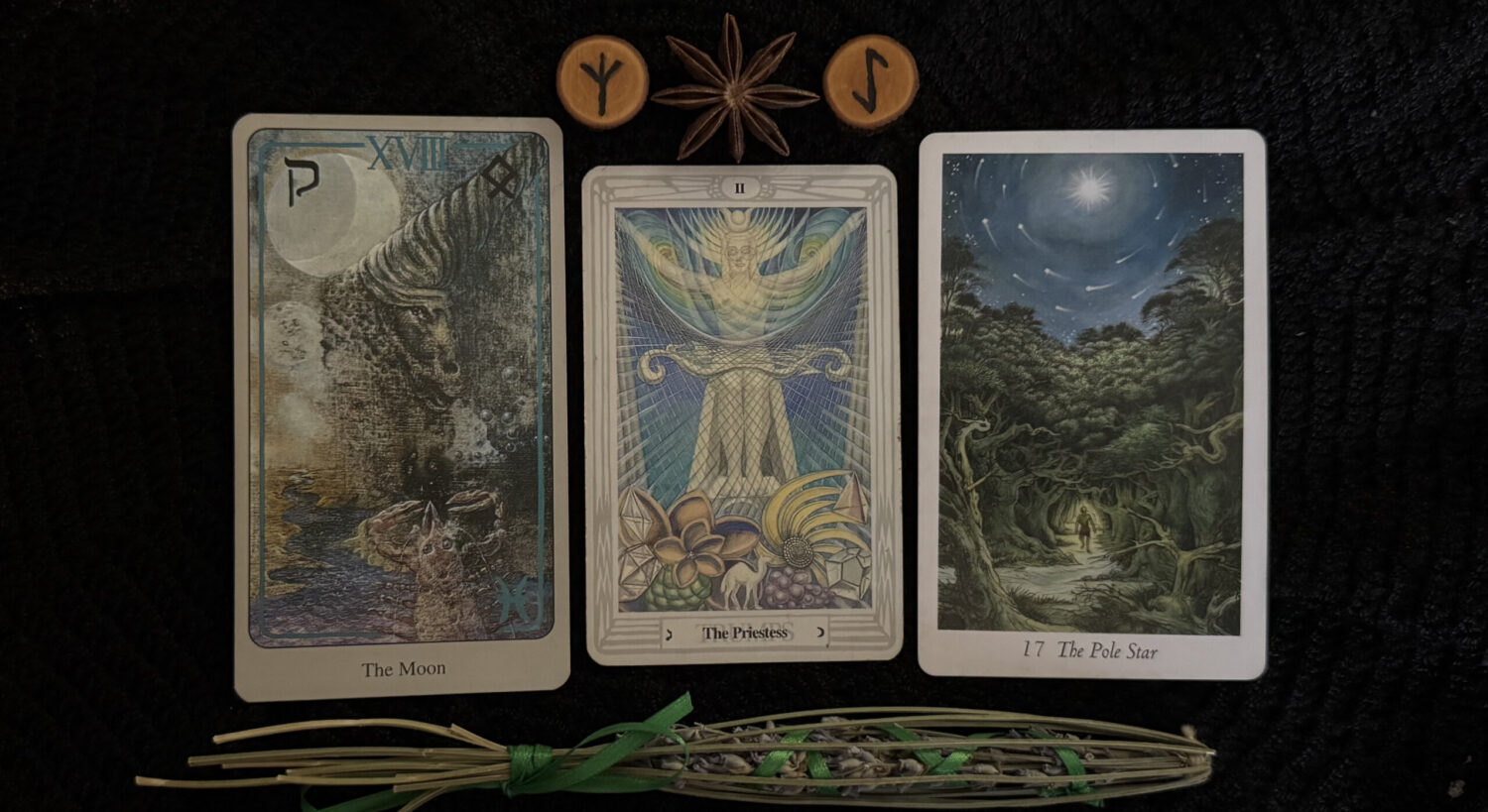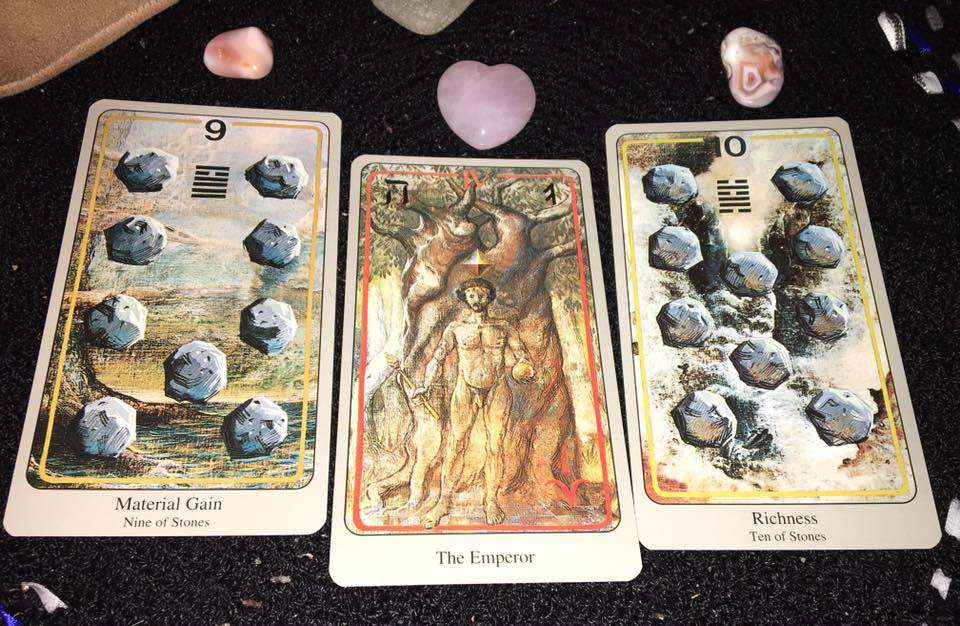First of all, this deck is right up there with Thoth in coolness. A blend of traditional Tarot, I Ching, Runes, and Kabbalah along with astrology and cultural traditions make up this amazing deck by Hermann Haindl and Rachel Pollack. I’ve not had a deck that used Stones in lieu of Pentacles or Disks before, and the cards themselves rival Lady Frieda Harris’s painting of the Thoth Tarot in their beauty and symbolism. This deck is as much an oracle style deck as it is a tarot deck. And I already find myself responding intuitively to the cards.
The Emperor stands in front of the Yggdrasil, the Tree of Life, standing his ground, full of power and vitality as he interacts with the world at large. Ansuz appears up in the right hand corner as the rune of Odin, expressing our spiritual inner voice. The tree resembles the stag with its antlers reaching for the nonphysical realm. Yggdrasil strikes the balance between physical and nonphysical presence with the Emperor holding that creative power in his hands. Represented by the number 4, the Emperor brings structure and discipline to his endeavors.
The other two cards represent the Earth Element suit of Stones, Pentacles or Disks in other decks. This suit typically represents our material presence in the world, or wealth as it’s gained or achieved. The 9 of Stones represents material gain. The stones are positioned in somewhat of a balanced fashion, more heavily weighted toward the bottom of the card signifying material gain versus a more spiritual one.
The 10 of Stones seems as if the wealth gained is now appreciated for the comfort and security it brings. The sun is in the background and the card has a lived-in feel to it, much like a long-time family home. The structure feels established to me, a life well-lived.
I suppose if one’s life isn’t going well, then the question to ask is, what is keeping you from your own power? Are you the arrogant Emperor, or are you comfortable in your own expression of Self? What’s keeping you from achieving all that you can in life? It’s easy to point fingers at all the external issues we face daily, but at the end of the day, most of the time whatever issues that get in the way of our success begin and end with each of us. We create the reality we see. Could we be seeing our life in a way that doesn’t foster success?
Additionally, how do we define wealth? Is it only monetary gain, or do we consider our spiritual wealth as well? The 9 of Stones feels a little scattered to me, sort of floating about in the air above the sea. Along comes the Emperor who appears concerned with his alignment as he stands tall in front of Yggdrasil. Achieving that, the 10 of Stones feels more defined than the 9 does. And it also feels within. As if by going within and aligning with Source Presence, illustrated by the Emperor standing in alignment with Yggdrasil, we gain a richness of Spirit that material gain simply cannot provide.
A note about the I Ching symbols on the 9 and 10 cards. Da You appears on the 9 of Stones, and from The Complete I Ching:
In Chinese, da means great, and you means possession. Da You means possession in great measure. Both Wilhelm and Blofeld translate Da You as Great Possession. However, in ancient times you also meant harvest. According to the spirit of this gua, there is no sense of possession, but it does reveal the light of a harvest. Confucius’s Commentary on the Decision says,
His virtue is firm and strong and also brilliant. He corresponds with Heaven And acts in accordance with time. Thus there is supreme progress and success.
To maintain virtue, it is not appropriate to take any action of possession. Corresponding with Heaven and acting in accordance with time suggests an act of harvesting.¹
Jing, or replenishing, is the I Ching symbol on the 10 of Stones. It represents a well where replenishment is taken after feeling exhausted or spent.
The structure of the gua is Water above, Wood below. This image gave the ancient sage the picture of a well. The water in a well was practically an inexhaustible resource. It was in constant use yet continually refilled. It was the source of life. The image also suggests that the roots of a plant draw water from the soil to nourish the stalk and leaves.²
With virtue defined as not taking any action of possession, that would seem to suggest that our true wealth is found in our expression of Source Presence rather than in the acquisition of possessions. But to be fair, this reading could simply suggest that standing in your own power can result in acquisition of wealth and comfort.
In any event, I love this deck! The Court cards are gorgeous and have a sacred tradition focus, a departure from traditional decks. I look forward to exploring more of what these cards have to share. Besides, the Major Arcana cards include runes. Runes!!!
~Blessings!
References:
- Huang, Taoist Master Alfred. The Complete I Ching — 10th Anniversary Edition: The Definitive Translation by Taoist Master Alfred Huang (Kindle Locations 2798-2805). Inner Traditions/Bear & Company. Kindle Edition.
- Huang, Taoist Master Alfred. The Complete I Ching — 10th Anniversary Edition: The Definitive Translation by Taoist Master Alfred Huang (Kindle Locations 6821-6824). Inner Traditions/Bear & Company. Kindle Edition.
If anyone intends to either quote something I've written, or intends to post any part of my work, including my videos, on any other site, please ask permission before doing so. Any reposting of my work without permission can be considered as copyright infringement, so please ask. And if I give permission, you MUST clearly reference my name as author and my website. No exceptions. The words an author writes are sacred. Unapproved use is not.
Thank you... Jan Erickson

